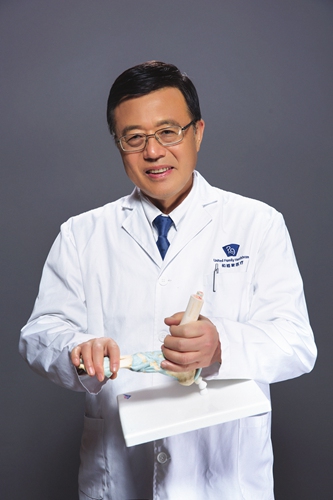Orthopedics is one of the common and important departments in hospitals, it can be roughly divided into four categories, such as the trauma, spine surgery, foot and ankle surgery and pediatric orthopedics, and it can also be subdivided into sports medicine, said Lu Jike, the chair of the department of orthopedics at Beijing United Family Hospital (BJU), who has developed expertise in orthopedics sports medicine, physiotherapy, pain management, and orthopedic geriatrics.
In terms of the spine, it is the most significant pillar of the human body, which can protect and support the head. Lu said that it is normal for people’s spine to undergo degenerative changes after the age of 25, which means that the intervertebral discs are dehydrated, and sometimes there are bone spurs formation.
Yet, like the mobile phone users and the office workers, who always keep their heads down, the curvature of the neck disappeared and its physiological state changes. It can cause tension and irritation in the muscles and ligaments, and the disordered of facet joints. The pressure on the intervertebral disc will gradually increase, which can lead to neck pain, arm numbness, dizziness and headaches and so on. These symptoms are also called cervical spondylosis, he added.
According to Lu, most of his patients are young or middle-aged, especially office workers; therefore, “people should have a lifestyle activity modification, which means protecting your cervical spine with a good style of work and life. For example, computers, laptops and smartphones should be placed at the same level as your eyes. Some exercises should be done for a long time to relax neck muscles, and it is important for people to choose the suitable pillow as well.”

Lu Jike, the chair of the department of orthopedics at BJU. Photo: Courtesy of BJU
Generally, for young people with changes in the curvature of the cervical spine, they will get better without surgery, after some rehabilitation and physical therapy at BJU and teaching them some simple techniques to improve their daily activities. But, some middle-aged and elderly patients, who have long-term cervical spondylosis, herniated disc, spinal stenosis, unstable walking and stumbles, need to have spine surgery.
There is a specific operation performed by the department of orthopedics at BJU. An American patient who had a herniated thoracic intervertebral disc after a fall could not find a hospital in Beijing that could accept him due to his body weight of over 110 kilograms. There was no operating table able to bear his weight, and he was also unable to undergo a MRI. “BJU could do this, we performed surgery on him, and he recovered very quickly,” Lu said.
“We have the most advanced concepts, the advanced technology, modern equipment and the strongest spine surgery team to serve our patients,” he said.
In terms of modern equipment, there is a Mako robotic that assists hip knee replacement surgery at BJU. The Mako robot system greatly reduces the incidence of patients with leg length inequality, hip dislocation, and implant loosening due to accuracy problems after surgery. For the patient, it means less surgically invasive procedure, faster rehabilitation and improved quality of life.
“BJU provides more personalized services. The orthopedics department forms a closed-loop system of patient-centered services, which means that all orthopedic related problems of patients can be solved in one-stop service in the department. And we are patient-oriented; they have the right to choose the doctor and to decide on further treatment together, rather than the doctor’s arbitrary decision. This is the philosophy of Beijing United Family Hospital,” Lu said.
Speaking on the further development of orthopedics department at BJU, Lu sated that, going forward, the work of sports medicine will be a key specialty in BJU. “We also have introduced some new technologies and new equipment in sports medicine with the new attention and treatment for our patients,” he said.
Lu Jike(right) talks with a patient at BJU. Photo: Courtesy of BJU


